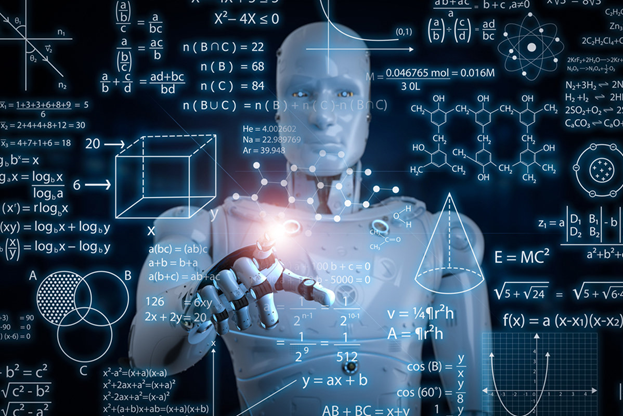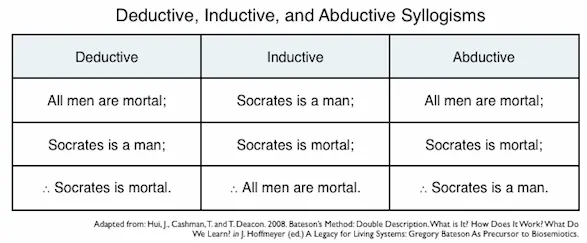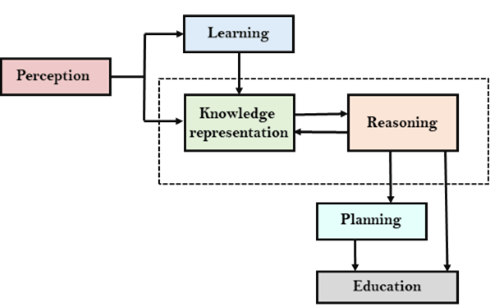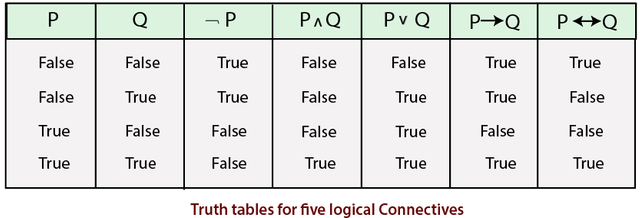- Propositional Logic
- What is knowledge?
- What is reasoning?
- Types of different reasoning methods
And let's dive into the topics, starting with Propositional Logic.
PROPOSITIONAL LOGIC

Source
Propositional logic, also known as Statment logic, is a means of joining together different statements, or propositions each with a truth value which can be either of the two; True (T) or False(F). These statements are presented with variables and we can combine these statements to create compound statements.

Now, you might ask how do you combine them? We combine them using logical connectives such as:
- AND (∧)
- OR (V)
- NOT (¬)
Example:
Consider that you have two statements with the variables "p" and "q":
| p : It is raining. | q : I carry an umbrella. |
|---|
You can combine these statements and make a new one out of them, for example:
A.) It is raining and I carry an umbrella.
B.) It is raining and I am not carrying an umbrella.
C.) It is not raining or I am carrying an umbrella.
Using the logical connectives, you can represent them in variable or symbolic notation:
A.) p ∧ q
B.) p ∧ ¬ q
C.) ¬ p V q
Depending upon the truth value of individual statements, you can determine the truth value of the compound statement. For AND, both statements must be True for the compound statement to be true, and for OR, at least one statement needs to be True. Negation (NOT) represents the inverse of a statement.
Propositional Logic also has a way of representing statements that imply something or when statements are dependent on each other, or when one statement follows another.

- IMPLICATION (→)
- BI-IMPLICATION (↔)
Examples of such statements:
A.) p implies q.
B.) q follows from p.
C.) p if and only if q.
D.) p is sufficient for q.
E.) p is necessary for q.
And the list goes on. However, propositional logic does not provide us with a means of representing statements that includes multiple objects of the word, or relations of objects with one another. For that, there is an extension of Propositional Logic known as Predicate Logic or First-Order Logic (FOL). It is a powerful technique to represent statements that include objects of the words, their relations, and also certain functions applied to them. Following are its basic elements:
- Constants: 1,2,3... any name, any place or thing, they all fall under this element.
- Variables: a,b,c...x,y,z... which we use to represent our statements.
- Predicates: Father, Brother... which is a certain property an object possesses.
- Functions: sqrt(square root), Mean, Maximum, Minimum... functions to be performed on the objects.
- Connectives: ∧, V, ¬, →, ↔.
- Quantifiers: Universal Quantifier (∀), which is used for all. Existential Quantifier (∃), which is used for some.

WHAT IS KNOWLEDGE?
Knowledge refers to the things, facts, and everything else you know which you gained in some manner or experienced in your lives. Human Intelligence is a systematic process of reasoning, and without some knowledge, you can't reason about anything. There may be some knowledge that is common to all, which is known as General Knowledge, they included certain facts which don't require much proving, then comes the Domain Knowledge, which is related to specific fields, topics, which themselves can have further sub-domains. There are two types of knowledge at the very top:
Declarative Knowledge:
This type of knowledge declares certain information, gives a description of concepts, and it is also static in nature, meaning it does not keep changing continuously. And why is that? Because it is based on facts! For example, The Sun rises in the East, now it can have only two values, i.e True, or False, it is a fact, we all know that the Sun indeed rises in the East which gives this statement a True value and it does not require any proof. Declarative Knowledge provides all the necessary information about any problem or situation in terms of simple statements having a truth value.
Procedural Knowledge:
As the name says it, the knowledge which is based on certain steps, a definite procedure of carrying out things. It derives information based on Rules, Actions, Agendas, Strategies, etc. Examples include:
- A computer program.
- Food Recipes.
- Riding a bicycle.
- An algorithm.

WHAT IS REASONING? AND ITS DIFFERENT METHODS
It can be easily understood by the sentence:
The process of working with knowledge, facts, and problem-solving strategies to draw conclusions.
It is pretty straight forward and what reason actually is, is simply inferring and drawing out conclusions from existing facts and statements. The inference is how we reason from given knowledge or the knowledge we already have, using that, we make new conclusions, new facts, and new information. There are also many different rules of inference that help us draw valid conclusions, initially these rules didn't seem to work on machines, but now with the advancement of technology and AI, they are easily implemented and machines help us make intelligent, smart, and important decisions almost everywhere.
In AI, reasoning is essential, and to help in that, the machine should also be able to use Rules of Inference, otherwise it would take a lot of time to perform something, and it would lead to exhaustive searches. Reasoning helps in making predictions from available knowledge, facts, or beliefs and similarly, in machines, they make these predictions using the data they have been taught or programmed. However, the conclusions drawn must be logical, they must be linked with the initial facts and they must make sense as they are used to take actions, and make decisions. Reasoning also involves calculation but unlike arithmetic, it deals with logic, predicates, quantifiers, propositions, and not with numbers, but with variables representing those statements.

TYPES OF REASONING METHODS
1.) Deductive Reasoning: This includes deducing new information from logically known information. Such arguments have statements that automatically lead to a conclusion.
For example:
All men are mortal.
Subject "A" is a man.
From these two statements, we can easily conclude that Subject "A" is mortal.2.) Inductive Reasoning: It differs from Deductive Reasoning in such a way that, it draws more general conclusions, such conclusions are generalized and drawn from a limited set of information and statements.
For example:
Observation: All crows I have seen in my life are black.
Conclusion: All crows are black.
However, it is a probable conclusion and it is also possible that not every crow is black. Deductive reasoning gives us a correct conclusion while Inductive reasoning gives a probable conclusion.3.) Abductive Reasoning: A form of deduction that allows for a plausible inference which means, that the conclusion might be wrong as well.
For example:
Implication: She carries an umbrella if it is raining.
Axiom: She is carrying an umbrella.
Conclusion: It is raining.
Here, the conclusion can also be false, it is also possible that she is carrying an umbrella due to some other reason such as scorching sun, and it isn't raining.

Source4.) Analogical Reasoning: In this method of reasoning, we compare two things, their similarities, and dissimilarities, and draw conclusions.
For example: Driving a truck and a car is almost the same, but there are some similarities in both the vehicles and some dissimilarities.5.) Non-Monotonic Reasoning: This method is used when facts of some situation are likely to be changed after some time.
For example, The wind is blowing and the curtain is swaying.
But, what happens if the wind stops blowing? If we work in a non-monotonic system, the curtain will stop swaying at some time and we would have a different conclusion. We keep track of the thing that caused a fact to be true and draw a conclusion from it, and then we keep backtracking to that thing and if it goes away, the conclusion is also negated.6.) Common-Sense Reasoning: It is actually an informal means of reasoning and uses rules and knowledge that have been gained through experience or learned, also known as Rules-of-Thumb.
7.) Knowledge-Based Reasoning: Compared to the rest, there is a difference, such reasoning manipulates symbolic information using AI principles. Here, symbolic information is considered more qualitative than numeric one, which is more quantitative.

Source
CONCLUSION
So, that was it for my lecture of Week-03. Now, I hope you have an idea of Propositional Logic, and you got to know about Knowledge, Reasoning, and different reasoning methods which are used. If there is anything you like to add, I'd be more than happy to know it. Thank you for giving it a read. Stay healthy and keep yourselves safe!
Thanks to the admins and moderators of this community:
@cryptokraze
@siz-official
@vvarishayy
@farhan-nabeel
@suboohi

You can delegate your SP to @siz-official and take benefit of our Delegation Rewards Offer of getting up to 200% Curation Rewards
You can also use these quick delegation links. Just click on your desired amount of SP you want to delegate and it will be done in process of 1 minute.
50 100 200 300 400 500 1000
2000 3000 4000 5000 10000








Informative post Keep sharing the valuable post. Artificial Intelligence is also the part of the life.
Regard. @muhammadsameer
Downvoting a post can decrease pending rewards and make it less visible. Common reasons:
Submit
Good post dear friend keep it up bro and keep learn with our steem fellows and friends.
Regards, Faran Nabeel
Downvoting a post can decrease pending rewards and make it less visible. Common reasons:
Submit